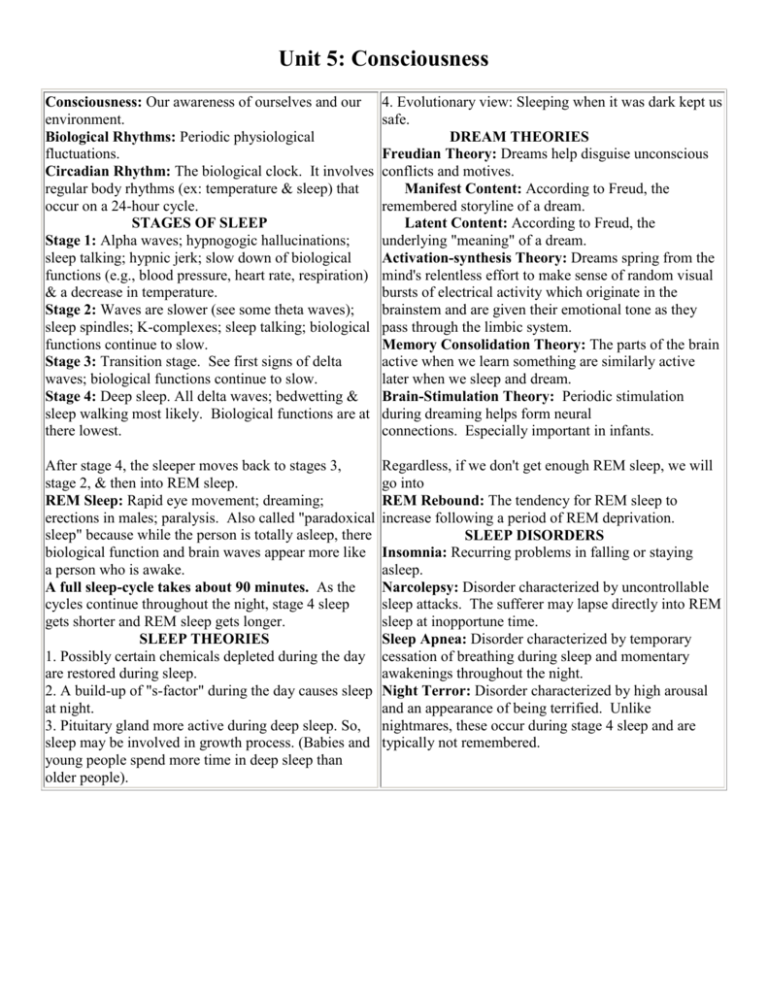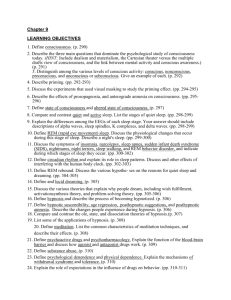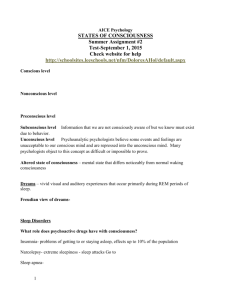Unit 5: Consciousness - Squalicum High School
advertisement

Unit 5: Consciousness Consciousness: Our awareness of ourselves and our environment. Biological Rhythms: Periodic physiological fluctuations. Circadian Rhythm: The biological clock. It involves regular body rhythms (ex: temperature & sleep) that occur on a 24-hour cycle. STAGES OF SLEEP Stage 1: Alpha waves; hypnogogic hallucinations; sleep talking; hypnic jerk; slow down of biological functions (e.g., blood pressure, heart rate, respiration) & a decrease in temperature. Stage 2: Waves are slower (see some theta waves); sleep spindles; K-complexes; sleep talking; biological functions continue to slow. Stage 3: Transition stage. See first signs of delta waves; biological functions continue to slow. Stage 4: Deep sleep. All delta waves; bedwetting & sleep walking most likely. Biological functions are at there lowest. 4. Evolutionary view: Sleeping when it was dark kept us safe. DREAM THEORIES Freudian Theory: Dreams help disguise unconscious conflicts and motives. Manifest Content: According to Freud, the remembered storyline of a dream. Latent Content: According to Freud, the underlying "meaning" of a dream. Activation-synthesis Theory: Dreams spring from the mind's relentless effort to make sense of random visual bursts of electrical activity which originate in the brainstem and are given their emotional tone as they pass through the limbic system. Memory Consolidation Theory: The parts of the brain active when we learn something are similarly active later when we sleep and dream. Brain-Stimulation Theory: Periodic stimulation during dreaming helps form neural connections. Especially important in infants. After stage 4, the sleeper moves back to stages 3, stage 2, & then into REM sleep. REM Sleep: Rapid eye movement; dreaming; erections in males; paralysis. Also called "paradoxical sleep" because while the person is totally asleep, there biological function and brain waves appear more like a person who is awake. A full sleep-cycle takes about 90 minutes. As the cycles continue throughout the night, stage 4 sleep gets shorter and REM sleep gets longer. SLEEP THEORIES 1. Possibly certain chemicals depleted during the day are restored during sleep. 2. A build-up of "s-factor" during the day causes sleep at night. 3. Pituitary gland more active during deep sleep. So, sleep may be involved in growth process. (Babies and young people spend more time in deep sleep than older people). Regardless, if we don't get enough REM sleep, we will go into REM Rebound: The tendency for REM sleep to increase following a period of REM deprivation. SLEEP DISORDERS Insomnia: Recurring problems in falling or staying asleep. Narcolepsy: Disorder characterized by uncontrollable sleep attacks. The sufferer may lapse directly into REM sleep at inopportune time. Sleep Apnea: Disorder characterized by temporary cessation of breathing during sleep and momentary awakenings throughout the night. Night Terror: Disorder characterized by high arousal and an appearance of being terrified. Unlike nightmares, these occur during stage 4 sleep and are typically not remembered. Unit 5: Consciousness (cont.) HYPNOSIS Hypnosis: A social interaction in which one person (the hypnotist) suggests to another person (the subject) that certain perceptions, feelings, thoughts, or behaviors will spontaneously occur. Posthypnotic Amnesia: Supposed inability to recall what one experienced during hypnosis; induced by the hypnotist's suggestion. Posthypnotic Suggestion: A suggestion, made during hypnosis, to be carried out after the subject is no longer hypnotized; used by some clinicians to control undesired symptoms and behaviors (e.g., eat less, quit smoking, feel less anxiety, etc.). Hypnosis does not improve memory. In fact, it is likely to contaminate our memories. It is, however, useful in relieving PAIN. Possibly due to dissociation or a "split in consciousness". While part of the person is still aware of the pain, the conscious part of the person is not. Theories of Hypnosis 1. Divided Consciousness Theory: Suggests that dissociation occurs during hypnosis. A "split" in consciousness occurs. "Part" of the person is unaware of what is occurring, but another "part" is aware. This part is called: The Hidden Observer: Hilgard's term describing a hypnotized person's awareness of experiences, such as pain, that seem to go unreported during hypnosis. 2. Social Influence Theory: The subject simply becomes caught up in the "role" of being a hypnotized person. It involves role-playing, conformity, and obedience. DRUGS AND CONSCIOUSNESS Psychoactive Drug: A chemical substance that alters perceptions and mood. Tolerance: The diminishing effect with regular use of the same dose of a drug; requiring the user to take larger and larger doses in order to obtain the same effect. Withdrawal: The discomfort and distress that follow discontinuing the use of an addictive drug. Physical Dependence: A physiological need for a drug, marked by unpleasant withdrawal symptoms when the drug is discontinued. Psychological Dependence: A psychological need to use a drug, such as to relieve negative emotions. Psychoactive Drugs Depressants: Drugs (such as alcohol, barbiturates, and opiates) that reduce neural activity and slow body functions. Barbiturates: drugs that depress the activity of the CNS, reducing anxiety but impairing memory and judgment. Opiates: Opium and its derivatives (such as morphine and heroin); they depress neural activity, temporarily lessening pain and anxiety. Stimulants: Drugs (such as caffeine, nicotine, and the more powerful amphetamines and cocaine) that excite neural activity and speed up body functions. Amphetamines: Drugs that stimulate neural activity, causing speeded-up body functions and associated energy and mood changes. Ecstasy (MDMA): A synthetic stimulant and mild hallucinogen. It produces short-term euphoria. However, it harms serotonin-producing neurons causing long-term changes in mood and cognitions. Hallucinogens: Psychedelic ("mind-altering") drugs, such as LSD and marijuana, that distort perceptions and may evoke sensory images in the absence of sensory input (i.e., hallucinations). THC: The major active ingredient in marijuana. NEAR-DEATH EXPERIENCES Near-death Experience: An altered state of consciousness reported after a close brush with death (such as after a cardiac arrest); often similar to druginduced hallucinations. Monism: The belief that mind and body are different aspects of the same thing (when the body dies, so does the mind. Dualism: The belief that mind and body are two distinct entities (when the body dies, the mind may continue to exist).






